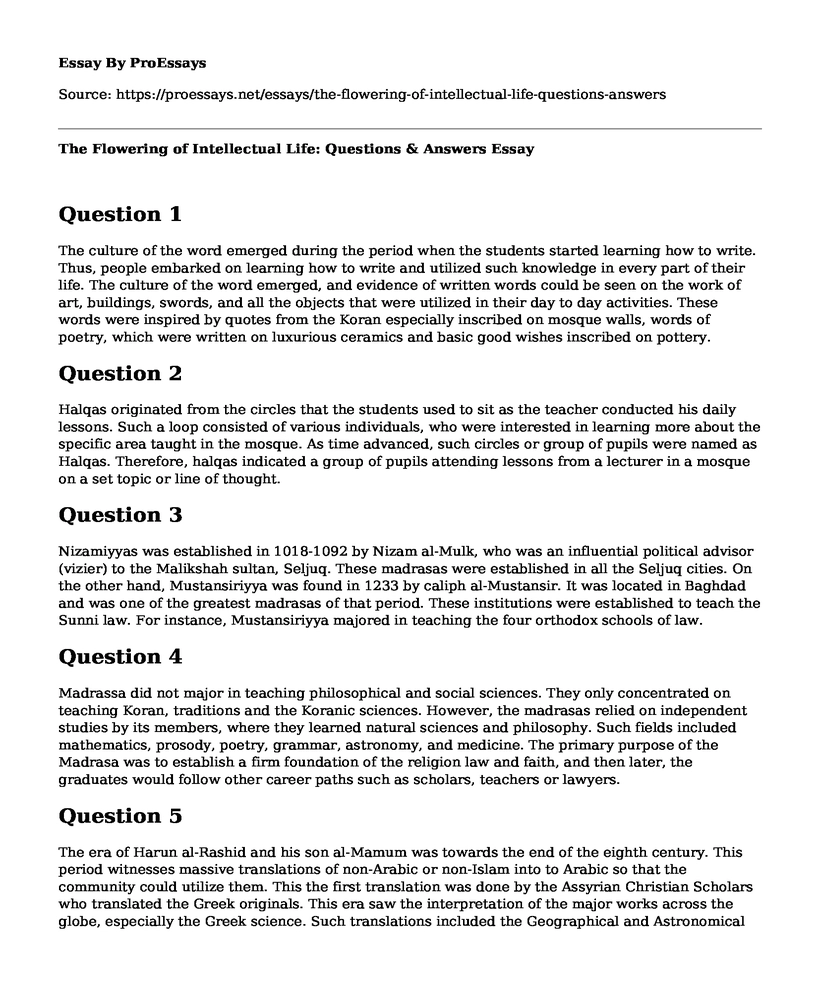Question 1
The culture of the word emerged during the period when the students started learning how to write. Thus, people embarked on learning how to write and utilized such knowledge in every part of their life. The culture of the word emerged, and evidence of written words could be seen on the work of art, buildings, swords, and all the objects that were utilized in their day to day activities. These words were inspired by quotes from the Koran especially inscribed on mosque walls, words of poetry, which were written on luxurious ceramics and basic good wishes inscribed on pottery.Question 2
Halqas originated from the circles that the students used to sit as the teacher conducted his daily lessons. Such a loop consisted of various individuals, who were interested in learning more about the specific area taught in the mosque. As time advanced, such circles or group of pupils were named as Halqas. Therefore, halqas indicated a group of pupils attending lessons from a lecturer in a mosque on a set topic or line of thought.
Question 3
Nizamiyyas was established in 1018-1092 by Nizam al-Mulk, who was an influential political advisor (vizier) to the Malikshah sultan, Seljuq. These madrasas were established in all the Seljuq cities. On the other hand, Mustansiriyya was found in 1233 by caliph al-Mustansir. It was located in Baghdad and was one of the greatest madrasas of that period. These institutions were established to teach the Sunni law. For instance, Mustansiriyya majored in teaching the four orthodox schools of law.
Question 4
Madrassa did not major in teaching philosophical and social sciences. They only concentrated on teaching Koran, traditions and the Koranic sciences. However, the madrasas relied on independent studies by its members, where they learned natural sciences and philosophy. Such fields included mathematics, prosody, poetry, grammar, astronomy, and medicine. The primary purpose of the Madrasa was to establish a firm foundation of the religion law and faith, and then later, the graduates would follow other career paths such as scholars, teachers or lawyers.
Question 5
The era of Harun al-Rashid and his son al-Mamum was towards the end of the eighth century. This period witnesses massive translations of non-Arabic or non-Islam into to Arabic so that the community could utilize them. This the first translation was done by the Assyrian Christian Scholars who translated the Greek originals. This era saw the interpretation of the major works across the globe, especially the Greek science. Such translations included the Geographical and Astronomical books such as the Ptolemy's works, Galen's publication on medicine, and Euclid's publication on geometry. Towards the end of the ninth century, significant works such as the Archimedes, Ptolemy, and Apollonius had been translated by the Abbasid mathematicians.
Question 6
Ibn-Khaldun was a great philosopher during the fourteenth century. He is accredited of differentiating the religious learning fields, which were majorly inspired by Gods revelation from falsafa, which he termed as based on deductions and observation. Such areas were not featured in the Madrasas but only in the school of law.
Question 7
In the 9th century, Baghdad was the center of translation of major Greek publications into Arabic. This enabled the Islam to have access to philosophical and natural science knowledge. This move resulted in various treatises, which had significant contributions to mathematics and geography. The translation saw the incorporation of the Hindu numerals into the Islamic lands. On the other hand, during the 11th and the 12th century, Toledo acted as the center for the translation of Arabic knowledge into medieval Latin. This resulted in extensive use of numerals in Europe from the ancient abacus to the Arabic numerals. This involved the rotation of Arabic numerals to form a new form of numerals such as 12356.
Question 8
The major event in the caliph's house of knowledge in Baghdad was the inception of the Indian numeral system into the Islamic world. The transition was facilitated by Muhammad ibn Musa al-Khwarizmi, who was great in Geography and mathematics. He originated from the Khwarizm region and drawn to Baghdad, where he inscribed the book Calculations with Hindu Numerals, which is considered as the primary contributor to the diffusion of Indian system to Islam.
Cite this page
The Flowering of Intellectual Life: Questions & Answers. (2022, Apr 04). Retrieved from https://proessays.net/essays/the-flowering-of-intellectual-life-questions-answers
If you are the original author of this essay and no longer wish to have it published on the ProEssays website, please click below to request its removal:
- Open Distance Learning
- Essay on Children Fairy Tales
- Critical Viewpoints Essay Example
- Advantages and Disadvantages of Silent Way - Paper Example
- Essay on Honor Codes: Essential for University President to Develop for Fair Playing Ground
- Paper Sample on Growing Up: A Child's Evolving Perception of Parents
- Essay on Fostering Vision and Mission Integration in Fine View School: Strategies and Communication Approaches







